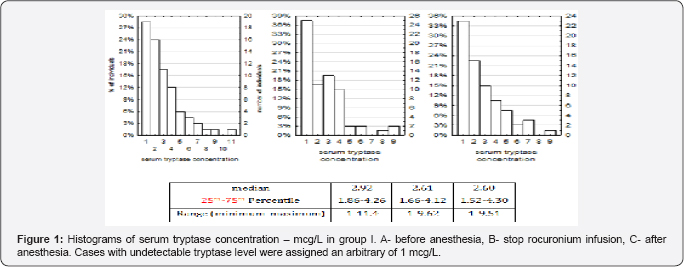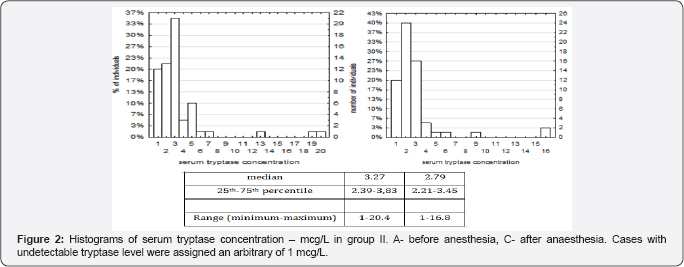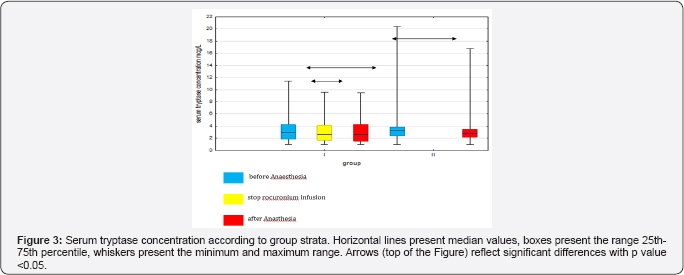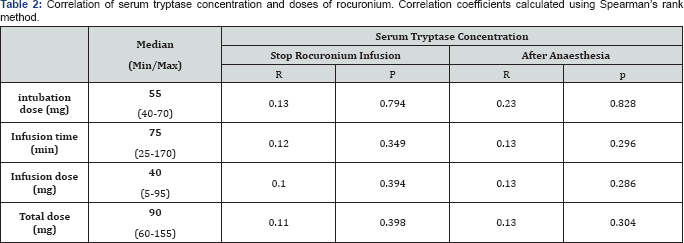Rocuronium does not Induce Serum Tryptase Elevation-Juniper Publishers
Juniper Publishers-Journal of Anesthesia
Abstract
Introduction: Rocuronium is a aminosteroid
structured, non-depolarizing neuromuscular blocking agents (NMB).
Epidemiological data presents that the frequency of hypersensitivity
reactions caused by rocuronium have been increased. Determinations of
serum tryptase concentrations are interdisciplinary recommended in
diagnosis of its adverse reactions. No studies have been performed to
explain specific role of rocuronium doses on serum tryptase values. The
aim of this study was to investigate the potential effect of rocuronium
on serum tryptase concentrations.
Patients and method: The study included 126
women given a general volatile anesthesia: group I - 66 - using the
rocuronium and group II - 60 - without neuromuscular relaxants.
Information's about perioperative fluid therapy and doses of rocuronium
were noticed. The blood samples were collected to perform tryptase
concentration analysis: preoperatively - before anesthesia and
postoperatively - after recovery from anesthesia.
Results: Median preoperatively serum tryptase
concentration in group I was 2,92 and 3,27 mcg/L in group II,
respectively. The reduction of serum tryptase value was noticed in both
groups and attained the level of 2.60 mcg/L in group I and 2.79 mcg/L in
group II after anesthesia, (p<0.05). Analysis did not show a
correlation between the serum tryptase levels and the values connected
to the administration of rocuronium and perioperative fluid therapy. No
significant differences in the tryptase concentration between the groups
were identified.
Conclusion: In conclusion, the scheme of
volatile anesthesia with rocuronium did not induced any significant
changes in tryptase serum levels compared with the volatile method. The
study excluded the serum tryptase concentration dependence of rocuronium
and crystalloid dilutional effect. The most likely explanation of our
results are physiological changes and specific rhythm of fluctuations of
tryptase secrection. It seems prudent to confirm the effect of
rocuronium on serum tryptase on larger cohort of patients.
Keywords: Tryptase; Mast cell; Rocuronium Introduction
Perioperative hypersensitivity and anaphylaxis are
important issues in anesthesiology because its occurrence is related to
drugs and agents used in general anesthesia [1-4].
The greatest risk of hypersensitivity occurs during anesthesia for
female patients and it is connected with the induction phase using
skeletal muscle relaxants [5-7].
Aminosteroids including rocuronium cause hypersensitivity much more
often than isoquinoline derivatives and depolarizing agent. Due to the
fact that no hypersensitivity to inhalational anesthetic agents has been
shown only volatile induction and maintenance of anesthesia using an
anesthetic sevoflurane does not pose a risk of hypersensitivity [8-9].
Rocuronium - modern, aminosteroid neuromuscular blocker agent has
beneficial pharmacodynamic and pharmacokinetic profile. Many authors
presented that rocuronium is very good alternative relaxant in Rapid
Sequence Induction. Through the presence of sugammadex - specific
antagonist of rocuronium, using of this relaxant agent minimize risk of
postoperative respiratory failure. Epidemiological data presents that
the frequency of hypersensitivity reactions caused by rocuronium have
been increased. Due to the multiple advantages reports of triggering
allergic or hypersensitivity reactions caused by rocuronium create
doubts about the safety of application [10-12].
Determinations of serum tryptase concentrations are
interdisciplinary recommended in diagnosis of its adverse reactions.
Tryptase is the main serine protease stored and released by activated
mast cells - effector cells triggering hypersensitivity and anaphylaxis.
Measurements of serum tryptase concentration in normal condition
according to the manufacturer's product information ranges are 1-11,4
mcg/L with the lower detection limit 1mcg/L [13-15].
No studies have been performed to explain specific role of rocuronium
doses on serum tryptase values. The aim of this study was to investigate
the potential effect of rocuronium on serum tryptase concentrations
during general anesthesia.
Experimental
Patients
The study was approved by the Bioethical Committee of
the Medical University of Bialystok UMB no. R-I-002/286/2009 and was
conducted at the Clinic of Anesthesiology and Intensive Therapy of the
Medical University of Bialystok. The research was conducted on 126
female patients with assessed perioperative risk according to the ASA
1-2 scale, without allergy related diseases, who were divided into two
groups according to the method of anesthesia being used. The study was
carried out on two groups of patients:
- Group I - 66 patients qualifying for the gynecological operation procedures under general volatile anesthesia with the muscle relaxant - rocuronium.
- Group II - 60 patients qualifying for thyroidectomy under general volatile anesthesia without NMB.
Methods of anesthesia
In the both groups volatile induction and maintenance
of anesthesia with inhalational anesthetic sevoflurane (Sevorane,
Abbvie) was performed. Analgesia was ensured through the administration
of intravenous fractional doses of fentanyl at 2 mcg/kg of body mass
(Fentanyl, Polfa S.A.). After the end of the surgical procedure the
administration of sevoflurane was stopped and access to fresh gasses was
increased. During the induction of anesthesia patients of Group I,
after the attainment of adequate level of anesthetic sleep, a skeletal
muscle relaxant rocuronium (Esmeron, Organon) was administered dosed at
0.6 mg/kg of body weight and neuromuscular monitoring of muscle function
applying four consecutive stimuli or the TOF (Train-Of-Four) method
through the TOF-Watch device. Tracheal intubation was performed after
reaching a TOF response level of 0. When muscle function returned to TOF
4 continuous infusion of rocuronium at a speed required achieving TOF 0
was administered. The continuous infusion of rocuronium was stopped at
the moment of surgical closing of the peritoneal cavity. After the
appearance of respiratory movement and the return of neuromuscular
function to the level of TOF 25% 0.5 mg of atropine (Atropinum
sulfuricum, Polfa) and 1.5 mg of neostigmine (Polstygmina, Pliva) was
administered intravenously. Extubation was performed in hemodynamically
stable patients with preserved, normal spontaneous respiratory function
at TOFR (TOF Ratio) of 0.8-0.9. In group II patients no skeletal muscle
relaxants were used. After attaining adequate level of anesthetic sleep
tracheal intubation was performed.
Serum tryptase concentration analysis
Blood samples were taken during the periooperative period to assess the level of tryptase in blood serum:
In group I the concentration of tryptase in blood
serum was tested in samples taken before the administration of
anesthesia, after stopping the infusion of rocuronium and at the end of
administration of anesthesia.
In group II the concentration of tryptase in blood
serum was determined from samples taken before and after the
administration of anesthesia.
Determination of the concentration of tryptase in
blood serum was performed using the immune fluoroenzymatic test UniCap
Tryptase manufactured by Pharmacia Diagnostics AB.
Statistical Analysis
Conformity assessment of empirical distribution of
studied parameters was performed using the Shapiro-Wilk test. Since most
empirical distributions obtained differed significantly from normal
distributions a comparison of the data was assessed by non-parametric
tests. The differences in the levels of parameters obtained through the
period of observation were assessed using the Wilcoxon signed-rank
(paired difference) test and to determine the differences in the level
of parameters being considered between the groups of patients the
Mann-Whitney U test was used. Correlation coefficients were calculated
using Spearman's rank method. Probability values of p < 0.05 were
accepted as significant. Group data were expressed as means and standard
deviations (SD) or as medians and range when appropiate. Obtained
results were subjected to statistical analysis using the STATISTICA12.0
(Stat Soft Inc., Tulsa, OK, United States) software.
Results
Patients of both groups did not differ when considering their age and anthropometric characteristics (Table 1).
The study ascertained that the concentration of serum tryptase in both
groups of patients became significantly reduced after anesthesia (Figure 1 & 2).
The median value of serum tryptase concentrations in group I was 2.92
mcg/L preoperatively and fell to the level of 2.60 mcg/L after
anesthesia. The reduction of concentration of tryptase in serum was also
noticed in group II and before anesthesia was at 3.27 mcg/L and
attained the level of 2.79 mcg/L (p<0.05) after anesthesia. In group I
the drop in the concentration of tryptase in blood serum after the
finish rocuronium infusion and after the end of administering
anesthetics was 10.62 and 10.96% (p<0.05), respectively. In group II
the recorded decrease in the concentration of tryptase in blood serum
after anesthesia reached 14.68% (p<0.05)



In two patients in group II postoperative serum
tryptase concentrations were higher than 11,4 mcg/L. In this cases
preoperative tryptase values were 20,40 and 19,10 mcg/L and decreased by
4,10 and 2,30 respectively. No significant differences in the
concentration of tryptase in serum between the two groups of patients at
various levels of anesthesia have been identified through the analysis (Figure 3).
We did not show a correlation between the serum concentration and the
values connected to the administration of rocuronium and parameters
connected with fluid therapy. The concentration of tryptase both at the
time of stopping the infusion of rocuronium as well as at the moment of
ending anesthesia did not demonstrate a correlation with the
administered intubation dose, the dose administered as an infusion or
the total dose of that relaxant (Table 2 & 3).



Discussion
Perioperative hypersensitivity and anaphylaxis
reactions are increasing and important subject in anesthesiology. Most
reports come from West Europe, Scandinavia, New Zealand and Australia
and in this countries incidence was estimated between 1:10 000 - 1:20
000, with mortality rate ranging 3.54.7%. Many authors have demonstrated
that rocuronium is the neuromuscular blocking agent which causes
anaphylaxis or hypersensitivity reactions the most often during general
anesthesia. Hypnotic intravenous medicaments, opioids, antibiotics,
latex, radiocontrast agents may also induce similar symptoms [2,3,4,7].
Only the volatile method of anesthesia using sevoflurane is not
connected with any risk of inducing hypersensitivity reactions or
anaphylaxis [1,6].
Many authors have described a female predominance, especially in
adverse allergic reactions to muscle relaxants with the female: male
ratio 8:1 to 3:1 [3,5-7].
Diagnosis of hypersensitivity reaction connected with
neuromuscular blocking agents is complicated. Cross reactivity between
myorelaxants groups are very common. Chemical and food allergies exhibit
cross reactivity with other chemical groups of medicaments [16,17].
Confirmation of its adverse reactions should be based on measurements
of serum tryptase concentrations and the identification of allergens
using skin tests [6,18].
Determination of the serum tryptase value is a very important way of
diagnosis and is recommended by international multidisciplinary
committees. Due to enzyme stability under different external
environmental condition, tryptase determination is a reliable and
effective method of confirming the occurrence of anaphylaxis [1-2].
The aim of this study was to investigate the
potential effect of rocuronium on serum tryptase concentrations. To
minimize the possible confounding from gender factor and make the study
more helpful in clinical aspects the study group consisted of women
undergoing a gynecological operation under general anesthesia with
rocuronium and the control group - women undergoing a thyroidectomy
under general anesthesia without using any neuromuscular blocking
agents. The median value of serum tryptase concentrations were in group I
2.92 mcg/L and in group II 3.27 mcg/L, respectively. Comparing
preoperative and postoperative serum tryptase values a significant
decrease of 0.23 in group I and 0.61 in group II, (p<0.05), was
found. In the study we did not observe any symptoms of hypersensitivity
reaction during general anesthesia and perioperative period.
Results of the study performed by Laroche et all
demonstrated that mean serum tryptase levels in resuscitation during
perioperative anaphylaxis was 86.5 mcg/L [19].
The results of our study are similar with Garvey's observations. After
general anesthesia and orthopedic surgery serum tryptase concentration
decreased from median value 4,07 to 3,45 mcg/L, giving variation 0,45.
Garvey et all considering causes of decreasing serum tryptase
concentration during general anesthesia presented a theory of dilutional
effect of crystalloid fluids infusion [20]. Many authors have reported the role of intravenous infusion and oral intake on hematological blood parameters [21-23].
However, no such studies have been performed directly for serum
tryptase concentrations. In our study no significant differences in
fluid therapy between the two groups have been presented. In order to
reduce the dilutional effect of crystalloid fluids infusion the blood
samples were taken from isolated venopunctured site. Mean volume of
intravenous crystalloid fluids administered during anesthesia in the
group I was 1274.24 ml, in group II it was 1319.16 ml. Spearman’s
analysis did not present any correlation between postoperative serum
tryptase concentrations and the parameters of fluid therapy.
The changes of serum tryptase concentration in our
study confirm Brown's at all observations. The authors explained that in
absence of anaphylaxis serum tryptase values do not vary more than 2
mcg/L and specific rhythm in the changes of the concentration of serum
tryptase fluctuates around 0.26 mcg/L [15].
No studies have been performed to explain specific effects of
rocuronium doses for serum tryptase values. In our study group the mean
intubation dose of rocuronium reached 56.06 mg, the mean dose given in
infusion was 40.37 mg, while the mean total dose was 96.43 mg and the
postoperative serum tryptase concentrations did not correlate with
parameters of rocuronium doses.
Conclusion
In conclusion, the study ascertained that the serum
tryptase concentration in non- allergic female patients became
significantly reduced after general anesthesia with rocuronium and the
most likely explanation are physiological changes and specific rhythm of
fluctuations. Perioperative serum tryptase concentrations did not
correlate with parameters of rocuronium doses and parameters of fluid
therapy. The scheme of volatile anesthesia with rocuronium did not
induce any statistical changes in tryptase serum levels compared with
the volatile method. In women without suspected allergic medical history
using of rocuronium as neuromuscular blocking agent during volatile
general anesthesia is save. The limitation of our study was a relatively
small number of patients examined, and it seems prudent to confirm the
effect of rocuronium on serum tryptase on larger cohort of patients.
For more articles in Journal of Anesthesia
& Intensive Care Medicine please click on:
https://juniperpublishers.com/jaicm/index.php
https://juniperpublishers.com/jaicm/index.php
Comments
Post a Comment